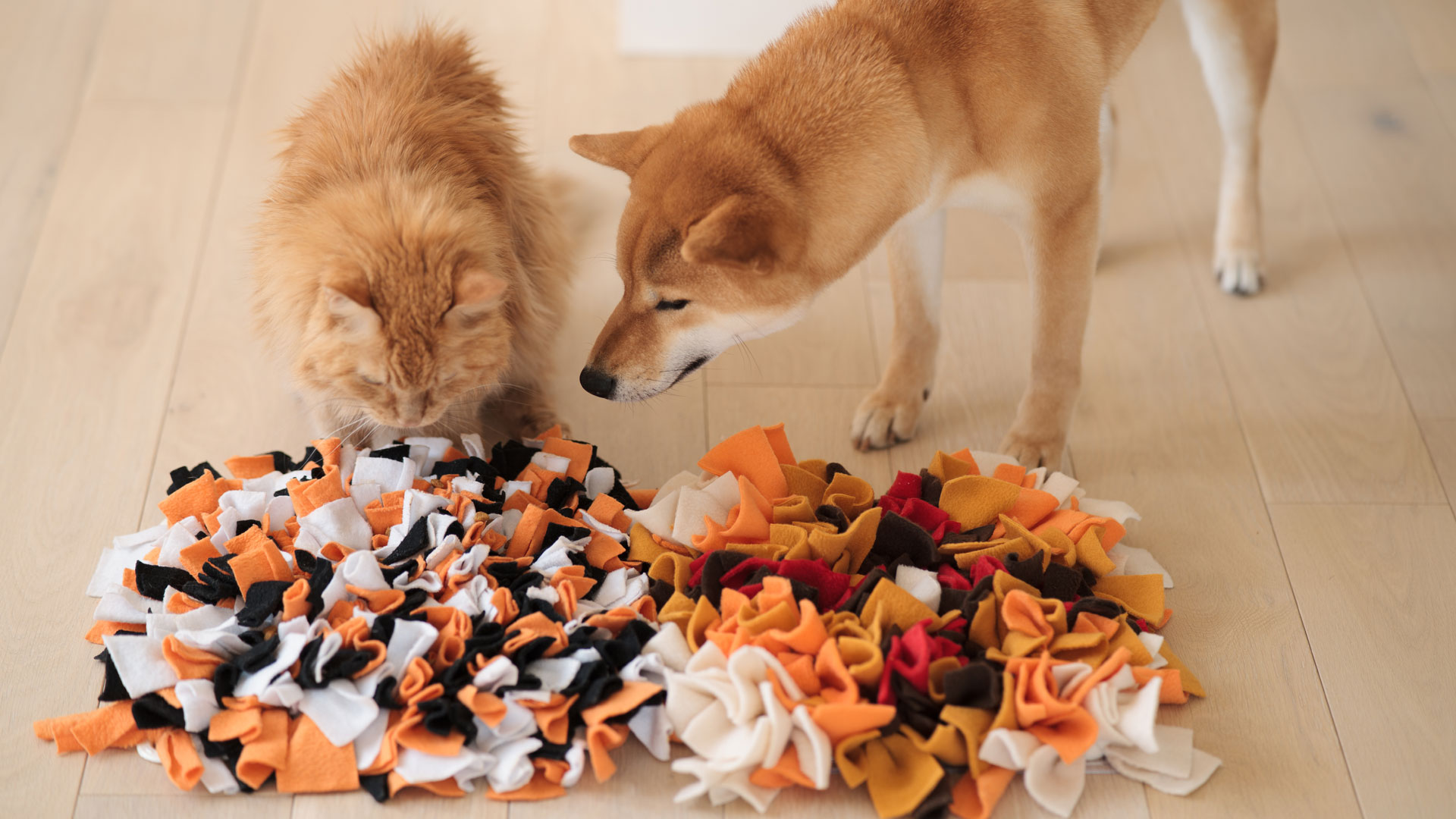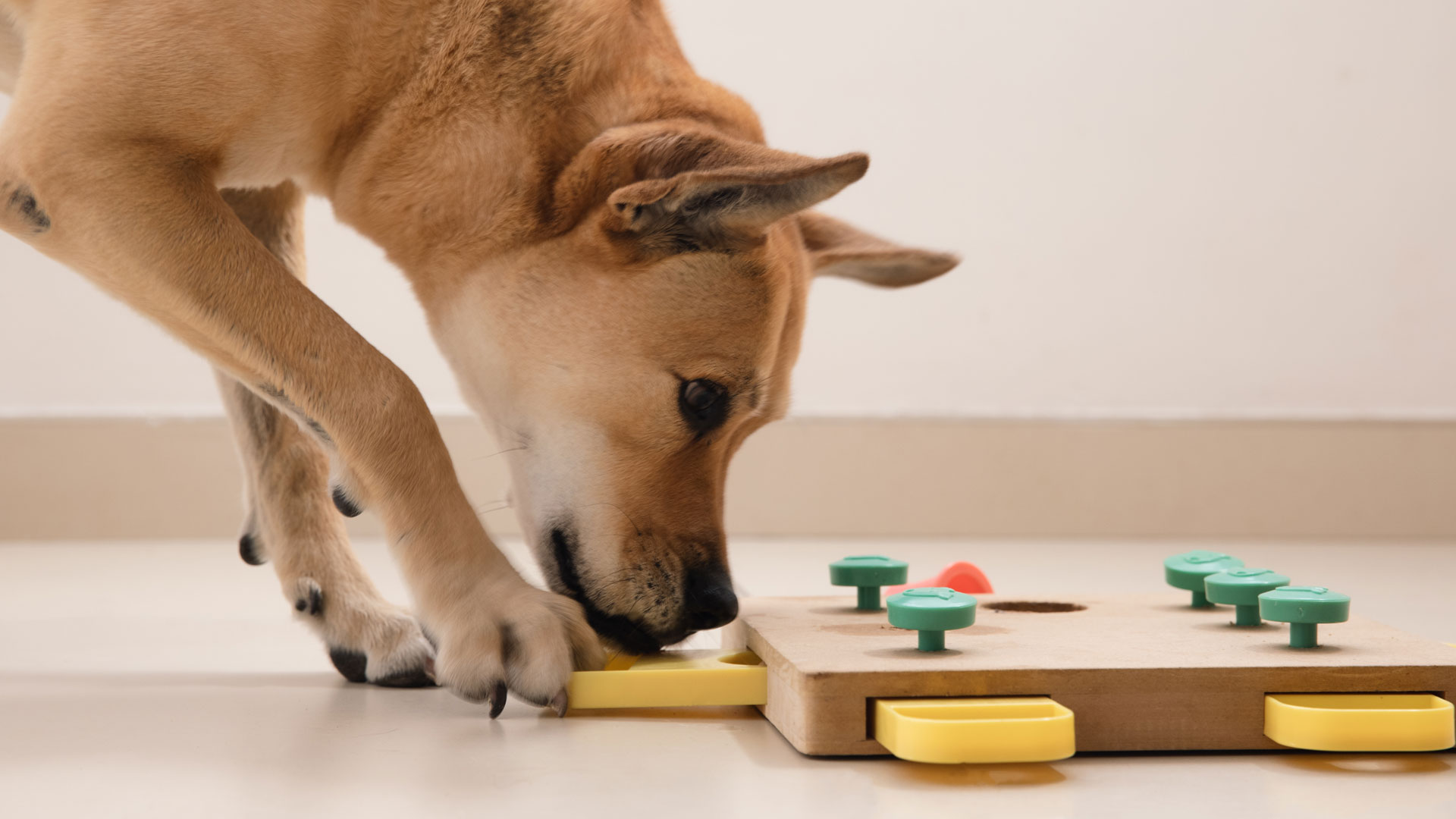My dog doesn't like long walks so I use these four brain games to tire her out
My dog’s reactivity can make long walks too stressful, so I’ve got some handy tricks up my sleeve to provide her with mental enrichment instead

My border collie Fenwick is jam-packed with breed-typical energy, but despite this, she’s not a fan of long walks. This has nothing to do with her enjoyment of the outdoors, it’s simply because she has trouble existing around other dogs without becoming overwhelmed. Due to an undiagnosed chicken allergy that left Fenwick severely ill when she was a puppy, she wasn’t given as much socialization as she should have had. This meant that moving objects (especially if dog– or car–shaped) can make her fixate.
We’ve, of course, made changes to Fenwick’s diet and have introduced the best dog food for allergies. I’ve also been working hard on getting Fenwick to be able to exist around dogs without losing all focus on me, going on long walks is still beyond her capabilities. However, I still need to give Fenwick an outlet for all of her boundless reserves of energy. Thankfully, I’ve got four foolproof ways to tire her out so that she snoozes away the rest of the day.
1. Food puzzles
If you want the ultimate hands-off way to occupy your dog, food puzzles can be an absolute lifesaver. Whether you purchase one, or you DIY it yourself, it’s a fantastic way for your dog to build confidence and tire itself out. Fenwick is a seasoned connoisseur of food puzzles, from kibble rolled up in a towel to this Kong food puzzle with a fun gyro design.
I asked Lara Sorisi, an APDT-certified dog trainer, why food puzzles can be so beneficial for your pup. ”Food puzzles are a psychologically healthy activity for a dog, just like brain games are good for stretching your mental muscles as a human. It can keep the brain active in older dogs and build brain development in younger dogs. Plus, it can also be a deterrent for inappropriate and unwanted behaviors.”
“Dogs were originally designed to work for their food, so using a puzzle feeder can satisfy this need. Try to think about what type of puzzle would suit your particular dog. Just as some humans might prefer a Rubik’s cube over a crossword puzzle, dogs will have their own set of preferences. You want to make sure that your dog is mentally stimulated by the puzzle and actively enjoys it – if they start to show signs of frustration then it’s no longer fun for them. You should be able to raise and lower the criteria to gain the food as needed, which is a good way to prevent frustration.”
“You can buy one of the best dog puzzle toys, but you can also make your own as well. In fact, one of my favorite books is ‘Brain teasers for dogs’ by Christina Sondermann. The puzzle games are all really cheap and easy to make and there are different types of puzzles for all kinds of dog personalities. I think I’ve tried almost every single puzzle in there and I think they’re all great.”

Lara Sorisi is a science-based and force-free dog trainer that has been training dogs for six years. She is accredited by the APDT (Association of Pet Dog Trainers), which is one of the most rigorous dog training qualifications available. Lara holds a bronze-level qualification with UK Sniffer Dogs, which means that she is an accredited UK Sniffer Dogs instructor. She’s also formally competed in gundog trials for three years.

2. Scentwork
Despite her current mental inability to walk long distances, Fenwick still has all the energy you’d expect from a border collie. However, I’ve found that a good 10-15 minute session of scentwork training can really tire her out. This is because dogs use a huge part of their brain when they’re exploring a scent.
Get the best advice, tips and top tech for your beloved Pets
Lara says that, “I’ve never met a dog that doesn’t really enjoy doing scentwork. Not only is it a great form of mental enrichment, but it’s also a good way for dogs to fulfill their predatory sequences. Plus, the act of sniffing is calming for dogs, so it’s perfect for any pup that has anxiety or reactive tendencies”.
I use this Kong hack to practice scentwork with Fenwick, as red Kong toys actually have a unique chemical scent that dogs are able to easily distinguish from other toys.
3. Dog parkour
If you see the word ‘parkour’ and you’re imagining your dog doing superhero-worthy leaps between buildings, then let me put your mind at ease! Dog parkour (also known as urban agility) is all about getting your dog to move through its environment and conquer any obstacles in its path. It’s a fantastic way to build confidence in your dog and get it to explore new environments.
There are a few basic concepts that I’ll regularly practice with Fenwick. We have a ‘Paws-on’ command, where she puts her front two paws on a safe object (such as a park bench). If it’s safe to do so, we’ll also do the ‘Four-paws’ command, which is where she will fully get onto a raised area. You can also ask your dog to get inside something (our favorite item at home is our washing basket) or pass underneath something (such as a chair or a bench).
While this is a fun brain-teasing activity at home, it’s also a great way to get nervous dogs to explore environments that they’re not 100% comfortable with yet. When I take Fenwick to a new place, I’ll often practice a little bit of dog parkour with her before we set off on her walk. I always find that this increases her confidence and resilience for the forthcoming walk. You can find out more at the dog parkour official website.

4. Agility basics
Recently, I started taking Fenwick to agility classes with a fantastic instructor. She’s truly taken to the sport and is improving every single week (and, as a proud dog mum, I’m relentlessly annoying all my friends and family with endless videos of her progress!). Doing agility absolutely exhausts Fenwick – I’ve truly never seen her more tired than after her weekly half hour sessions.
I’ve been practicing the basics at home, using some cheap weave poles and jumps that I bought from Amazon. I have a relatively small garden, but these 10–15 minute bouts of highly structured training are all Fenwick needs to be calm and settled for the next few hours. In fact, one session in the morning and another at lunchtime is more than enough mental and physical enrichment to tire her out for the whole day – this is perfect when I’ve got a busy day and don’t have much time to do longer activities with her.
Looking for other ideas for training your dog? Take a look at our advice on how to stop a dog from jumping up.
Louise Carey is a freelance writer and the Editor of sister website Top Ten Reviews. She has been working in publishing for seven years, contributing to publications including The Independent, TechRadar, Digital Camera World and more. As the proud pet parent of a reactive border collie with a food allergy, it’s been necessary for Louise to explore a variety of fun and exciting ways to enrich an energetic dog that can’t always go on walks. She’s passionate about sharing the information she’s learned to help other pet owners as well.

